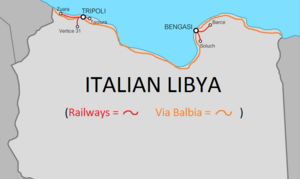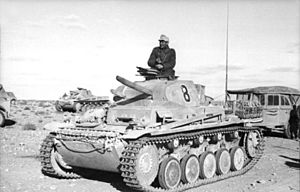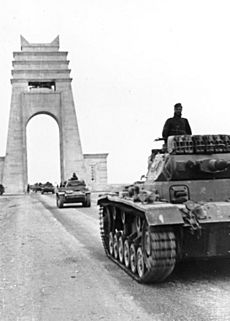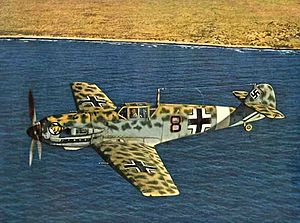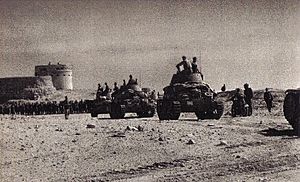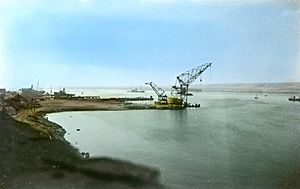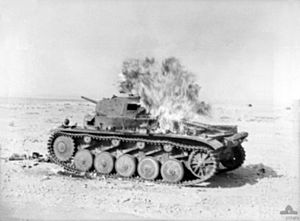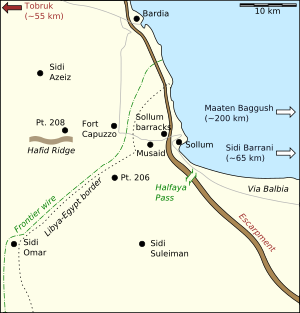Operation Sonnenblume facts for kids
Quick facts for kids Unternehmen Sonnenblume/Operation Sunflower |
|||||||||
|---|---|---|---|---|---|---|---|---|---|
| Part of the Western Desert Campaign of the Second World War | |||||||||
 Map showing the area and events of Operation Sonnenblume (enlargeable) |
|||||||||
|
|||||||||
| Belligerents | |||||||||
| Commanders and leaders | |||||||||
| Units involved | |||||||||
| Deutsches Afrikakorps 10ª Armata (10th Army) |
Cyrenaica Command | ||||||||
| Strength | |||||||||
| Elements of 2 German divisions Elements of 5 Italian divisions |
1 division 3 brigades 1 armoured brigade (understrength) |
||||||||
| Casualties and losses | |||||||||
| 103–107 tanks (some temporary) | 3,000 POWs c. 100 per cent tank losses |
||||||||
Operation Sonnenblume (which means "Operation Sunflower" in German) was a secret plan during World War II. It involved sending German troops to North Africa in February 1941. This happened because the British army had badly beaten the Italian army in North Africa during a fight called Operation Compass.
The first German soldiers, part of the new Deutsches Afrikakorps (often just called the Afrika Korps), arrived in Libya on February 11, 1941. Their leader, Erwin Rommel, arrived the next day. His orders were to defend the city of Tripoli, but he was also told to be aggressive. Soon, German and Italian forces started moving forward. They quickly pushed the British back, capturing areas like El Agheila and Mersa Brega.
The British forces were not ready for Rommel's quick and bold attacks. Many of their best units had been sent to help Greece, and others were getting new equipment. Rommel's surprise moves helped the German-Italian forces win this early part of the campaign. They even managed to surround the important port city of Tobruk.
Contents
What Led to Operation Sunflower?
Italy's Invasion of Egypt
The war in the Western Desert began in 1940 when Italy invaded Egypt. Their goal was to capture the Suez Canal, a very important waterway. The Italian army, led by Marshal Rodolfo Graziani, advanced into Egypt and set up defensive camps near Sidi Barrani. They planned to build a new road to bring in more supplies before moving further east.
Operation Compass: The British Fight Back
In December 1940, the British Western Desert Force launched a surprise attack called Operation Compass. With about 30,000 soldiers, they quickly defeated the much larger Italian army. The British pushed through western Egypt and into Libya, capturing many towns like Bardia, Tobruk, and Derna. They took over 138,000 Italian and Libyan prisoners, along with many tanks and guns. The British had very few losses themselves.
After this big victory, the British army was very tired, and their vehicles were worn out. They also decided to send many of their experienced troops and equipment to help Greece. This left fewer, less prepared forces to defend the areas they had just captured in Libya.
The Siege of Giarabub
One of the last Italian strongholds to fall was the oasis of Giarabub. Australian soldiers surrounded this Italian position in December 1940. The Italian soldiers inside depended on air transport for supplies, but it wasn't enough. Many local troops deserted because of hunger. The Australians attacked in March 1941, and the Italian soldiers surrendered on March 21.
The Desert Battlefield
The fighting took place in the Western Desert, a wide, flat, and stony area. It was very hot during the day and very cold at night. Strong desert winds, called the Sirocco, would blow clouds of fine sand, making it hard to see and getting everywhere. This harsh environment made it difficult for vehicles and soldiers.
There was only one paved road, the Via Balbia, which ran along the coast. Other routes were just desert tracks. Finding your way was hard, and armies often got lost. Supplies were a huge challenge because everything had to be brought in from far away. German tanks, for example, often overheated in the desert heat.
Keeping the Armies Supplied
Getting supplies to the armies in North Africa was very difficult. Italian ships had to sail a long way around Sicily to avoid British attacks from Malta. Once supplies reached Tripoli, the main port, they had to be transported hundreds of miles by road to the front lines.
The Via Balbia road could flood and was often attacked by British planes. Moving supplies was slow and wore out vehicles quickly. Even when supplies arrived in Tripoli, there weren't enough trucks to move them to the soldiers fighting at the front. This meant that even if a lot of supplies arrived by sea, they often got stuck at the port.
The German Army Arrives
Germany Steps In
Germany decided to help Italy after the big defeat in Operation Compass. In January 1941, Adolf Hitler ordered that a "blocking detachment" be sent to North Africa. This was the start of Operation Sonnenblume. The first German troops arrived in Libya in mid-February, and their first tanks came a few days later.
The Afrika Korps
The Afrikakorps (DAK) was officially formed on February 19, 1941, to defend Tripolitania. German tanks were specially changed for the desert, with better engine cooling. The first tanks of the 5th Light Afrika Division arrived in March 1941. They were still painted dark grey, which was not ideal for the desert. Later, more tanks from the 15th Panzer Division arrived in April and May.
Who Was in Charge?
After the Italian commander was killed, General Italo Gariboldi took over the Italian forces. On February 12, Erwin Rommel arrived to lead the German Afrika Korps. Rommel was told to defend Tripoli, but he was known for his aggressive style. The Italian motorized units were placed under German command. Rommel quickly started moving his forces forward, even though the German high command didn't expect a full victory in Africa.
The British Forces in Cyrenaica
The British forces left to defend Cyrenaica were the 9th Australian Division and parts of the 2nd Armoured Division. British leaders like General Archibald Wavell thought the Germans wouldn't be ready to attack until May. They believed they would have more time to get their tanks fixed and bring in more troops.
However, the British forces were not in good shape. Many tanks were worn out, and there was a shortage of transport vehicles. This made it hard to move supplies or even move the troops around. Lieutenant-General Philip Neame took command of the British forces in Cyrenaica and warned that many tanks would break down as soon as they moved. He asked for more troops and air support, but Wavell said there wasn't much to send.
The Battle Begins
March 24 – April 2, 1941
On March 24, Rommel began his advance with the new Afrika Korps. He moved towards the British positions near Mersa Brega. British planes had seen German troops, but they didn't expect a big attack so soon. Rommel quickly sent his forces forward, splitting them into different groups to attack from different directions.
The British forces had to retreat from Mersa Brega. Rommel kept pushing his troops forward quickly, even though the Italians thought they should wait for more fuel. Rommel wanted to trap the British.
April 3–5, 1941
On April 3, the British commander, Gambier-Parry, learned that a large enemy force was heading for Msus, where their main supply dump was. The British 3rd Armoured Brigade moved there, only to find that their fuel had been destroyed to keep it from the enemy. The tank brigade was already very weak due to losses and breakdowns.
Conflicting reports and confusion led to the British forces being disorganized. Rommel, meanwhile, kept pushing his forces, even ordering them to continue to Mechili and Tobruk. He split his forces into several columns, sending them along different routes to try and cut off the retreating British. Many German units also faced fuel shortages, but Rommel kept urging them forward.
April 6–8, 1941
On April 6, German forces reached Mechili and Derna, cutting off some British retreat routes. The British tried to fight back, but their tanks were few and worn out. The British commanders, Neame and O'Connor, were captured while trying to retreat.
Rommel planned to attack Mechili on April 7, but his forces were spread out, low on fuel, and tired. However, the British forces at Mechili, led by Gambier-Parry, were surrounded. After trying to break out, Gambier-Parry and about 2,700 to 3,000 British, Indian, and Australian soldiers surrendered to the Italian forces on April 8.
The Siege of Tobruk Begins
By April 8, the most advanced German units had reached Derna. Rommel wanted to chase the British all the way across Egypt and capture Alexandria. However, his supply lines were stretched too thin, and the British defense of Tobruk made this impossible.
On April 10, Rommel ordered his troops to prevent any breakout from Tobruk. The next day, the city was surrounded. Tobruk was defended by about 25,000 British and Australian soldiers. They had plenty of supplies and could get more from Egypt by sea. The garrison also had armored cars and captured Italian tanks, which they used to attack Axis supply convoys. This made it impossible for the Axis to invade Egypt.
What Happened Next?
Losses During the Operation
The British lost about 3,000 soldiers who were captured at Mechili on April 8. Several important British commanders, including Philip Neame and Richard O'Connor, were also captured. The British 3rd Armoured Brigade lost most of its tanks due to breakdowns, lack of fuel, or being destroyed to prevent capture. The Germans lost 103 to 107 tanks, but many of these were later repaired.
Later Battles
The Siege of Tobruk
From April 11 to 12, German tanks tried to attack the defenses of the 20th Australian Brigade near Tobruk, but they were pushed back by artillery. The Germans thought the British would evacuate Tobruk by sea, but the garrison stayed and fought. The Germans tried a bigger attack on April 13-14, but it was also stopped. After three weeks of attacks, Rommel stopped trying to capture Tobruk and instead began a long siege. Italian infantry divisions surrounded the fortress, while the main German forces stayed mobile to protect the frontier.
Operation Brevity
Operation Brevity was a small British attack on May 15-16. It was planned to hit the weak Axis forces along the Egyptian-Libyan border. The British had learned that the Axis forces were tired and low on supplies. The British captured some areas like Halfaya Pass and Fort Capuzzo, but German counter-attacks quickly regained the fort. The operation was called off because the British risked being caught by German tanks. German troops later recaptured Halfaya Pass in late May. The British then began preparing for a larger attack called Operation Battleaxe.
More to Explore
- List of World War II Battles
- North African campaign timeline
Orders of Battle
German Afrika Korps
- 5th Light Afrika Division
- Panzer Regiment 5 (with various Panzer I, II, III, and IV tanks)
- Reconnaissance Battalion 3
- 15th Panzer Division (arrived later)
- Panzer Regiment 8 (with Panzer II, III, and IV tanks)
- Motorized Rifle Regiment 104
- Motorcycle Battalion 15
- Reconnaissance Battalion 33
- Motorized Artillery Regiment 33
- Engineer Battalion 33
- Anti-tank and anti-aircraft units
British and Commonwealth Forces
- Cyrenaica Command
- 2nd Armoured Division (with various tank regiments and support groups)
- 9th Australian Division (with infantry brigades and support units)
- 3rd Indian Motor Brigade
- British Troops Egypt
- Various cavalry, artillery, and infantry units
- 7th Armoured Division (parts of)
- Polish Independent Carpathian Rifle Brigade
- 6th Infantry Division
- Layforce (Commando units)




